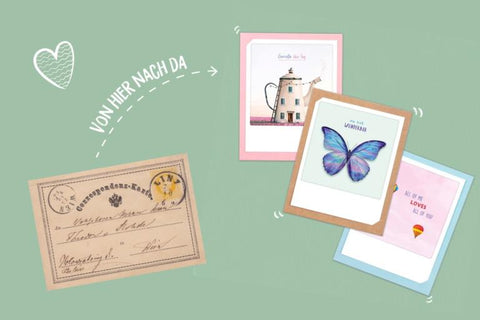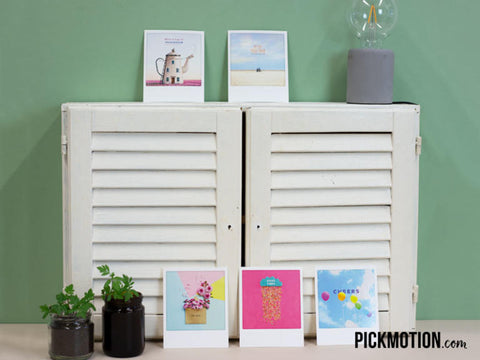
We come across postcards in a wide variety of shapes and colors. Whether with classic travel motifs or unusual illustrations and sayings - the cards are as diverse as the paths they take to us and the people who send them to us. But the cards always have one thing in common: they trigger a certain feeling in us. And they have been doing so for many years.
The first precursors of the postcard can be dated back to the 15th century, even if they didn't have much in common with today's postcards. At that time, there were small cards with Christian motifs that people gave each other with spoken New Year's greetings, because not everyone could write. Sending such cards was unthinkable at that time.
In the 18th century, the custom of exchanging business cards arose among the nobility and the bourgeoisie in France, which over time were increasingly decorated with pictures, while in England the custom developed of presenting pre-printed cards with illustrations and special embossing to the lady of one's heart on Valentine's Day.
Some time later, in the 19th century, a general custom began in Germany to assure one another of friendship and affection with small picture gifts and so-called "decorative cards". That almost sounds like our PICKMOTION cards, even if it's still a bit early for that. The postcard itself didn't exist yet, but the use of pictures and illustrations was becoming more and more common in correspondence. The first local publishers in seaside and travel resorts began to sell letterheads with views of places.
The first real postcard was sent by the writer Theodore Hook to himself in Fulham (London) in 1840. This was probably intended as a little amusement, as the card showed a caricature of postal workers.

Image source: Wikipedia

Image source: Wikipedia
The idea of the postcard, although under different names at the time, spread in the 1860s. First in the USA (here a law was passed in 1861 that allowed privately printed cards weighing less than an ounce to be sent by post) and then a little later in German-speaking countries, where the printed matter card was introduced as a precursor to the postcard - it was only permitted for printed texts (advertisements, business notices, price courante), was officially called an "open card" and no handwritten additions were permitted other than the details of the recipient, the sender, the date and the signature. On October 1, 1869, the "correspondence card" was introduced for the first time by the post office in Austria-Hungary, and it came onto the market in Germany in 1870. The postcard was given the name it still has today in 1872 - at that time it could only be sent nationally or to neighboring states. Three years later, it was approved for international shipping. This marked the birth of the postcard's international success.
For more than 30 years, the front of the postcard was intended for the address and the back for text or images. It was not until 1905 that the card found its current arrangement of elements with text and address on the back.
Over the years, an incredible variety of shapes and materials developed, with the standard format for postcards of 14.8 x 10.5 cm that we know today being introduced on October 1, 1927. Today, there are postcards with jagged edges, up to heart format, and every imaginable shape from landscape format to 360-degree panorama format, and many experiments have also been carried out with the material.

Source: suck.uk
The postcard had its heyday between 1885 and the end of the First World War in 1918. During this period, billions of postcards were sent every year. According to Deutsche Post, today's figures are in the three-digit million range, a third of which are sent in the summer months. The mailing figures show that postcards are still very popular and that for most people, despite increasing digitalization, they are still part of their vacation.
But it's not just the classic holiday greeting that can be sent with the cards. Even back when the postcard had found its way into private life, special cards for festive occasions quickly developed. From wedding cards to birthday cards, from Christmas cards to condolence cards and general greeting cards, there are now cards for every imaginable occasion. And finally, this also gave rise to the more festive variant of the double card (or folding card), which is sent in an envelope like a letter.

And that's how we come to us and our PICKMOTION postcards : fantastic photography, good vibes for the small, special moments in life and a freshly printed, good feeling in your hands to bring joy to yourself and your loved ones - very similar to the "decorative cards" at the beginning of the 19th century, only 200 years later.







